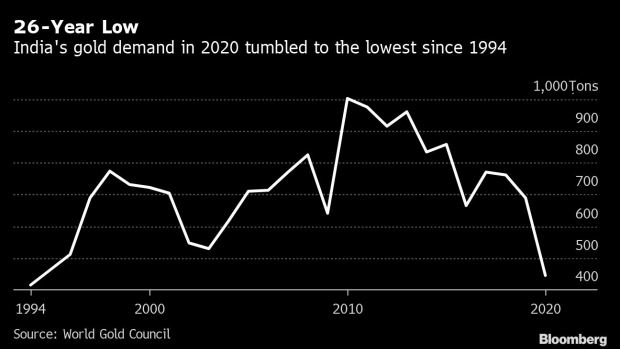Jan 28, 2021
Pandemic-Battered Gold Demand in India to Rebound in 2021
, Bloomberg News

(Bloomberg) -- Gold consumption in India, the world’s second-biggest buyer, is expected to rebound in 2021 after plunging to the lowest in more than two decades, according to the World Gold Council.
Demand is expected to jump closer to the 690 tons bought in 2019 as the country’s economy shows signs of recovery, P.R. Somasundaram, managing director at the council for India, said in an interview. Goldsmiths had one of the worst years in 2020, when demand slumped by more than a third to 446.4 tons, the lowest since 1994, as coronavirus-related lockdowns, curbs on movements, record high prices and lower incomes slashed spending on jewelry, WGC data showed.
“The price now is more acceptable and the 50,000 rupees level ($686 per 10 grams) has become the new normal,” Somasundaram said. “Also, going by what has happened in 2020, people will want to celebrate every little thing in 2021,” and that would benefit gold as weddings that were deferred take place this year, he said.
At the same time, interest rates are low and the stock market has run up too fast, so people will want to allocate more in gold to hedge their investment portfolio, he said.
Import Tax
Domestic bullion futures rallied 28% in 2020, the biggest jump in nine years. Jewelers are now looking to Monday’s federal budget for a possible reduction in import taxes. The current rate is 12.5%. India imports almost all the gold that it consumes and the duties plus local taxes make it expensive for buyers.
As consumption recovers, India will need to cut the duty to “reasonable levels” to curb smuggling, Somasundaram said. Illegal inflows may jump back to more than 100 tons this year after falling to a negligible amount in 2020, he said.
“We could see a strong spurt in gold demand for the next few years, a repeat of what happened after a sharp drop in 2009,” he said. “In such a scenario, the current high tax on gold increases the lure of smuggling, so a duty cut to reasonable levels is absolutely necessary, along with tax concessions for recycling gold, innovations and digital interventions.”
©2021 Bloomberg L.P.





